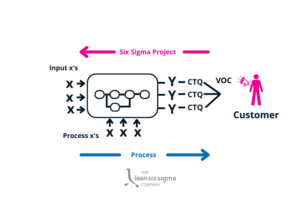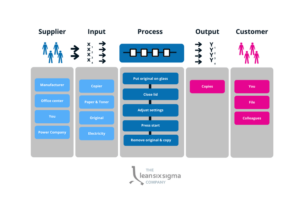The SIPOC model is a powerful tool within process improvement and project management, especially within Six Sigma methodology. SIPOC stands for Supplier, Input, Process, Output, Customer, and provides a structured framework for understanding and describing high-level processes. The model helps to identify the key steps in a process, those parties supplying and taking away material or information for the steps, and what is in and out of scope in the improvement project.
Overview of the Model
The SIPOC model consists of five main components:
- Supplier: This refers to the entities, both internal and external, that provide inputs needed to execute the process. Suppliers can be individuals, departments, or external organisations that contribute to the process.
- Inpust : Inputs are the materials, resources and data needed to carry out the process. This includes both tangible and non-tangible elements provided by the supplier and required to execute the process.
- Process: This is the set of activities that take place to convert the inputs into outputs that are valuable to the customer. The process is usually described with verbs representing the actions and steps in the process.
- Outputs: Outputs are the tangible products, services, or properties that result from the process. These outputs should meet the customer’s needs and can be either tangible or intangible.
- Customer: The customer is the person or organisation that receives the output of the process. This can be either an internal or external customer, depending on the nature of the process.
The figure below shows a schematic of a SIPOC process. Here, the inputs are named as Xs and the outputs as Y.
The Process of Creating a SIPOC Map
To create a SIPOC map, follow a structured approach:
- Identify the start and end point of the process: This includes determining where the process starts and ends, which often helps delineate the scope of the process.
- Define the process steps: Define the 4-7 steps that comprise the process, and connect them in a logical order to represent the flow of the process.
- Identify the outputs: Understand what products, services or information are generated by the process and what value they provide to the customer.
- Identify the customers: Determine who are the recipients of the process’ outputs, both internal and external, to understand whose needs the process serves.
- Identify key process inputs: Identify the critical input elements needed to start and execute the process.
- Identify key suppliers: Identify the suppliers of the inputs, understand what they provide, and how they affect the process.
- Validate the process map: Verify that the process map created matches the actual situation and that the process is actually executed according to this map. Also consider what the scope of the improvement project should be, i.e. which steps should be within scope and which out of scope.
The figure below shows a completed process map. Make sure each output has at least one customer and each input has a supplier.
Applications and Benefits
The SIPOC model is used for several purposes, including:
- Understanding the process flow at a high level.
- Identifying key stakeholders and their roles within the process.
- Validating the scope of projects and improvement initiatives.
- Communicating the process to stakeholders.
- Identifying areas for process improvement and optimisation.
- Determining the minimum representatives needed on the improvement team
The model provides a structured approach to analyse and improve processes, allowing organisations to operate more efficiently and achieve better results for their customers.
Conclusion
The SIPOC model is a valuable tool for process analysis and improvement, enabling organisations to understand, communicate and optimise processes in a structured way. By identifying the key elements of a process and relating them to customer needs, organisations can improve operational efficiency and achieve better results.
SIPOC AS PART OF OUR TRAINING COURSES
The SIPOC model is covered during our Green Belt, Black Belt Service, Black Belt Manufacturing training courses. Request our prospectus for more information on these training programmes.
Want to learn more or have a question?
Request our prospectus.


